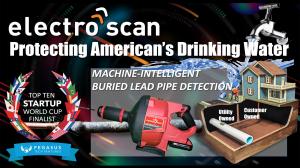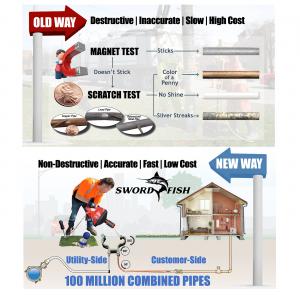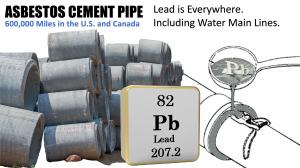Machine-Intelligent Lead Detection Solution Provider, Electro Scan Inc. Supports EPA's Lead and Copper Rule Improvements

Electro Scan Inc.'s SWORDFISH represents the world first machine-intelligent device that automatically detects buried pipe materials, including copper, galvanized, plastic, and lead pipes, without digging.

Cleantech entrepreneur, Chuck Hansen, Chairman & CEO, Electro Scan Inc. extended the leak detection capability of electrical resistance testing to identify toxic buried lead pipe, without excavating.

The task of replacing 100% of lead water service pipes has been compared to solving Y2K. This time its about protecting the health of the American drinking water system.
U.S. Water Utilities Face Accelerated Requirements to Replace 100% of Lead Service Lines and Galvanized Pipes for Utility-Owned and Customer-Owned Water Pipes.
Electro Scan Inc. and its award-winning SWORDFISH solution remains the world’s first commercial product that automatically determines pipe materials of buried lead pipe, including Copper, Galvanized Steel, Plastic, and Lead pipes, without digging or excavating.
Founded in 2011 by cleantech software entrepreneur, Chuck Hansen, Electro Scan Inc. was the first company to recognize the benefits of using electrical resistance testing to find leaks in pressurized & unpressurized water & sewer pipes.
Commonly missed by acoustic sensors (listening) and closed-circuit television cameras (seeing), Electro Scan’s low voltage conductivity solutions, as featured in the American Water Works Association (AWWA) M77 Standard of Practice for Condition Assessment of Water Mains (2019), automatically detects and measure leaks to the closest one-inch.
In 2015 Electro Scan engineers discovered its patented technology could accurately identify multiple pipe materials in larger diameter pipes, including lead and lead soldered joints. The discovery was made during a leak detection survey of a pressurized buried asbestos cement pipe.
“We applaud the EPA’s efforts to continue to protect public health through the lead and copper rule improvements,” says Chuck Hansen CEO of Electro Scan Inc.
“We look forward to helping drinking water professionals navigate what this means for their systems and communities to inventory and validate utility-owned and customer-owned water service lines.”
A Natural Resources Defense Council (NRDC) analysis of EPA data between January 1, 2018, and December 31, 2020, showed that 186 million people in the United States—a staggering 56 percent of the country's population—drank water from drinking water systems detecting lead levels exceeding the level of 1 part per billion (ppb) recommended by the American Academy of Pediatrics to protect children from lead in school water fountains.
Given that lead was banned for use in drinking water systems by the EPA in 1986, homes built before 1979 totaling more than 72 million homes, are at high risk to have lead water service lines.
The LCRI introduces significant enhancements to the existing Lead and Copper Rule Revisions, including a mandatory 10-year replacement requirement for lead and galvanized requiring replacement (GRR) service lines, continuous verification of unknown service lines, and a lower action level of exceedance from 15 ppb to 10ppb.
It is crucial to note that the LCRI is yet to undergo the legislative process before becoming law, and specific steps will be followed, with the anticipated effective date after baseline water service inventories are due October 16, 2024.
“The LCRI represents an accelerated timeline for water utilities to develop comprehensive inventories and replacement of all lead water service lines, including water lines on customer’s properties that were never the responsibility of publicly-owned or investor-owned water utilities,” emphasized Chuck Hansen.
Key recommendations contained in the 622-page pre-publication version of the LRCI, would:
• Require water systems to include connector materials in the service line inventory.
• Prohibit water systems from partially replacing lead or GRR services, unless part of an emergency repair.
• Require a street address of each service line & connector, and be made publicly accessible.
• Not limit inventory methods so water systems could take advantage of new ways to identify pipe materials.
• Create a market for service line material identification technologies.
• Establish a deadline to specifically identify UNKNOWN pipe materials for all service lines.
• Require water systems to re-inspect a service if the Customer thinks assigned material is incorrect.
• Require Customer Notice if pipe disturbances occur due to potholing or other inventorying efforts.
Water systems that have already replaced utility-owned lead pipes, without inspecting or replacing the related Customer's portion of the buried lead pipe, may be required to replace the remaining portion of the service line as part of the new pronouncement.
As part of the LCRI, the EPA revised its requirement to include disturbances due to inventorying efforts, such as potholing, to conform with the recommendations in the LCRR inventory guidance. The EPA also acknowledged that pipe disturbances can occur when individual service lines are shut-off or bypassed, such as operating a valve on a service line or meter setter.
Given the need for LCRI legislation to be approved by Congress, and then provide a three-year window to correctly inventory baseline utility and customer-owned water services, ten percent or more drinking water customers may have to wait until 2037 to have lead-free water service lines.
Currently the LCRI remains exclusively focused on pipes that connect homes and businesses to municipal and investor-owned water mains. And, does not include assessing lead in water distribution or transmission water lines.
Despite being banned in 1975, the water industry estimates that over 600,000 miles of asbestos cement (AC) pipe still serve water systems in the United States and Canada.
And, AC pipe joints commonly used melted lead to seal joints as part of industry accepted construction and installation standards.
As a result, drinking water customers may continue to record high lead levels from water taps, even after all lead service pipes have been removed.
For more information about how electrical resistance testing can help create, validate & verify your water service line inventory, contact Electro Scan Inc. at info@electroscan.com.
ABOUT ELECTRO SCAN INC.
Electro Scan Inc. is a leading international supplier of machine-intelligent pipeline assessment and quality assurance products and services for the water, sewer, and oil & gas markets. The company designs, develops, and markets proprietary equipment and delivers technical field services using its SaaS-based cloud application that automatically locates, measures, and reports leaks and water service line pipe materials, including lead pipes. The company's products and professional services detect buried lead water services on a house-by-house basis; typically not found by legacy inspection methods.
HASHTAGS
#acousticsensors #ai #amp8 #artificialintelligence #asce #askchuck #awwa #awwam77 #britishwater #californiadrought #chuckhansen #cipp #conditionassessment #conductivity #deeplearning #drainage #drought #dwi #electromagnetic #electroscan #epa #esg #esginvesting #fell #gettheleadout #gpm #infrastructure #innovyze #inspection #iot #lcri #lcrr #lcr #leak #leadpipe #leadetection #leaks #leakdetection #leakdetectionoftheyear2021 #lps #m77 #machinelearning #megadrought #ml #nassco #pacp #pcat #piperepair #pressuretransient #resilient #resiliency #satellite #sewer #sewerai #sustainability #swan #swordfish #trenchless #trident #usepa #utilities #wastewater #water #waterai #wsaa #worldbank #wsaa
Janine Mullinix
Electro Scan Inc.
+1 916-779-0660
email us here
Visit us on social media:
Facebook
Twitter
LinkedIn
Instagram
YouTube
Legal Disclaimer:
EIN Presswire provides this news content "as is" without warranty of any kind. We do not accept any responsibility or liability for the accuracy, content, images, videos, licenses, completeness, legality, or reliability of the information contained in this article. If you have any complaints or copyright issues related to this article, kindly contact the author above.


